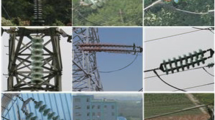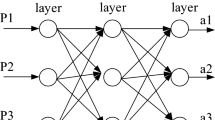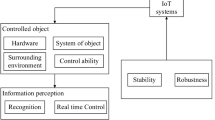Abstract
The Internet of Things (IoT) aims to meet the needs of smart services by combining multiple information intelligence tools and network technologies. In terms of technology, management, cost, policy, and security, the development of the IoT still faces many challenges. This study proposes an intelligent image detection and transmission system based on IoT communication, with the following primary objectives: First, this study aims to provide an early warning model based on Kalman Filtering Fast Fourier Transform Support Vector Machine (KF-FFT-SVM). It delivers early warning signals by analyzing and extracting historical features from surface motion data for a given period. The step size for spectrum analysis is determined by the signal frequency and is used to create a training dataset and train the SVM model. The use of a trained model for early warning can improve the accuracy of early warning evaluation. Second, the forward line of the video image is used as the necessary information in the content symbol retrieval process, and the information required for the structure is used to improve the quality as much as possible. Because of the search and influence of the transmission quality of digital components, the important data in the digital transmission space is used to ensure the accuracy of digital components while transmitting a small amount of energy. Third, when the device is connected to the network, other users can obtain information about the device via security breaches. The data must be transmitted by both parties using their own identities, which increases transmission security. The design idea of ZigBee technology follows the method of distributing information, such as food space through a zigzag-shaped dance, and low power consumption with low cost. Finally, to increase system efficiency, non-orthogonal multiple access technologies realize and transmit data from multiple users in time, frequency, and code zones while using various channels for each user. The wireless signal-enabled environment is changed by varying the reflection coefficient of the passive reflector units, which are components of the same mapping set as the smart reflector. To improve the effectiveness and performance of the system transmission, the wireless signal may have the effect of boosting the signal or removing interference.






Similar content being viewed by others
Data Availability
The experimental data used to support the findings of this study are available from the corresponding author upon request.
References
Dong, W., Li, Q., & Tang, Y. (2021). Image encryption-then-transmission combining random sub-block scrambling and loop DNA algorithm in an optical chaotic system. Chaos, Solitons & Fractals, 153, 111539.
Naik, R. P., Simha, G. G., & Krishnan, P. (2021). Wireless-optical-communication-based cooperative IoT and IoUT system for ocean monitoring applications. Applied Optics, 60(29), 9067–9073.
Li, C., Anwar, S., Hou, J., Cong, R., Guo, C., & Ren, W. (2021). Underwater image enhancement via medium transmission-guided multi-color space embedding. IEEE Transactions on Image Processing, 30, 4985–5000.
Ji, W., Ebrahimi, T., Li, Z., Yuan, J., Wu, D. O., & Xin, Y. (2021). Guest Editorial: Emerging visual IoT technologies for future communications and networks. IEEE Wireless Communications, 28(4), 10–11.
Kannan, C., Dakshinamoorthy, M., Ramachandran, M., Patan, R., Kalyanaraman, H., & Kumar, A. (2021). Cryptography-based deep artificial structure for secure communication using IoT-enabled cyber-physical system. IET Communications, 15(6), 771–779.
Hu, S., & Chen, W. (2021). Joint lossy compression and power allocation in low latency wireless communications for IIoT: A cross-layer approach. IEEE Transactions on Communications, 69(8), 5106–5120.
Li, W., & Wang, S. (2022). A fully distributed optimal control approach for multi-zone dedicated outdoor air systems to be implemented in IoT-enabled building automation networks. Applied Energy, 308, 118408.
Sheikhpour, S., Ko, S. B., & Mahani, A. (2021). A low-cost fault-attack resilient AES for IoT applications. Microelectronics Reliability, 123, 114202.
Satrasupalli, S., Daniel, E., & Guntur, S. R. (2021). Single Image Haze Removal Based on transmission map estimation using Encoder-Decoder-based deep learning architecture. Optik, 248, 168197.
Li, J., Zhao, Z., Li, R., & Zhang, H. (2018). Ai-based two-stage intrusion detection for software defined iot networks. IEEE Internet of Things Journal, 6(2), 2093–2102.
Tuli, S., Basumatary, N., & Buyya, R. (2019). Edgelens: Deep learning-based object detection in integrated iot, fog and cloud computing environments. In: 2019 4th International Conference on Information Systems and Computer Networks (ISCON) (pp. 496–502). IEEE.
Agnese, L., Natasha, C., & Roberto, P. M. (2021). Developing echolocation: Distinctive patterns in the ontogeny of the tympanoperiotic complex in baleen and toothed whales (Cetacea). Biological Journal of the Linnean Society, 2, 2.
Hettler, S., & Arenal, R. (2021). Comparative image simulations for phase-plate transmission electron microscopy. Ultramicroscopy, 227, 113319.
Zhang, W., Zhou, S., Sui, X., Gu, G., & Chen, Q. (2021). Single image detecting enhancement through scattering media based on transmission matrix with a deep learning network. Optics Communications, 490, 126896.
Su, B., Wang, S., & Li, W. (2021). Impacts of uncertain information delays on distributed real-time optimal controls for building HVAC systems deployed on IoT-enabled field control networks. Applied Energy, 300, 117383.
Muhammad, K., Hamza, R., Ahmad, J., Lloret, J., Wang, H., & Baik, S. W. (2018). Secure surveillance framework for IoT systems using probabilistic image encryption. IEEE Transactions on Industrial Informatics, 14(8), 3679–3689.
Hare, S., Golodetz, S., Saffari, A., Vineet, V., Cheng, M. M., Hicks, S. L., & Torr, P. H. (2015). Struck: Structured output tracking with kernels. IEEE transactions on pattern analysis and machine intelligence, 38(10), 2096–2109.
Wang, N., & Yeung, D. Y. (2013). Learning a deep compact image representation for visual tracking. Advances in neural information processing systems, 26.
Jia, X., Lu, H., & Yang, M. H. (2012). Visual tracking via adaptive structural local sparse appearance model. In: 2012 IEEE Conference on Computer Vision and Pattern Recognition (pp. 1822–1829). IEEE.
Chen, N., Chen, Y., Song, S., Huang, C. T., and Ye, X. (2016) Smart urban surveillance using fog computing. In: 2016 IEEE/ACM Symposium on Edge Computing (SEC), pp. 95–96. IEEE
Diro, A. A., & Chilamkurti, N. (2018). Distributed attack detection scheme using deep learning approach for Internet of Things. Future Generation Computer Systems, 82, 761–768.
Li, L., Ota, K., & Dong, M. (2018). Deep learning for smart industry: Efficient manufacture inspection system with fog computing. IEEE Transactions on Industrial Informatics, 14(10), 4665–4673.
Meng, Z., Liu, Y., Gao, N., Zhang, Z., Wu, Z., & Gray, J. (2021). Radio frequency identification and sensing: Integration of wireless powering, sensing, and communication for IIoT innovations. IEEE Communications Magazine, 59(3), 38–44.
Ahsan, W., Yi, W., Qin, Z., Liu, Y., & Nallanathan, A. (2021). Resource allocation in uplink NOMA-IoT networks: A reinforcement-learning approach. IEEE Transactions on Wireless Communications, 20(8), 5083–5098.
Zheng, H., Xiong, K., Fan, P., Zhong, Z., & Letaief, K. B. (2021). Age of information-based wireless powered communication networks with selfish charging nodes. IEEE Journal on Selected Areas in Communications, 39(5), 1393–1411.
Filipiak, P., Almairac, F., Papadopoulo, T., Fontaine, D., Mondot, L., Chanalet, S., & Wassermann, D. (2021). Towards linking diffusion MRI based macro-and microstructure measures with cortico-cortical transmission in brain tumor patients. NeuroImage, 226, 117567.
Razansky, D., Lafci, B., & Luis Dean-Ben, X. (2021). Transmission-reflection optoacoustic ultrasound (TROPUS) computed tomography of whole mice. The Journal of the Acoustical Society of America, 149(4), A19–A19.
Şen, S. S., Cicioğlu, M., & Çalhan, A. (2021). IoT-based GPS-assisted surveillance system with inter-WBAN geographic routing for pandemic situations. Journal of Biomedical Informatics, 116, 103731.
Ali, K., Nguyen, H. X., Vien, Q. T., Shah, P., Raza, M., Paranthaman, V. V., & Rodrigues, J. J. (2021). Review and implementation of resilient public safety networks: 5G, IoT, and emerging technologies. IEEE Network, 35(2), 18–25.
Yoshino, H., Ota, K., & Hiraguri, T. (2021). Traffic reduction technologies and data aggregation control to minimize latency in IoT systems. IEICE Transactions on Communications, 104(7), 706–715.
Jin, W., Song, M., Hu, W., Xue, Y. L., & Gao, Y. (2021). Diffraction propagation of light wave and image distortionless transmission in ten-fold symmetric photonic quasicrystal lattices. Optics Communications, 500, 127329.
Huang, R., Xiao, R., Zhu, W., Gong, P., Chen, J., & Rida, I. (2021). Towards an efficient real-time kernel function stream clustering method via shared nearest-neighbor density for the IIoT. Information Sciences, 566, 364–378.
Ding, Z. (2021). Harvesting devices’ heterogeneous energy profiles and QoS requirements in IoT: WPT-NOMA vs BAC-NOMA. IEEE Transactions on Communications, 69(5), 2837–2850.
Zhou, S., Sui, X., Zhang, W., Hua, Y., Chen, Q., & Gu, G. (2021). High-resolution image transmission through scattering media based on compressive encoding. Optical Engineering, 60(3), 035108.
Jung, J., Hong, J., & Yi, Y. (2021). On self-configuring IoT with dual radios: A cross-layer approach. IEEE Transactions on Mobile Computing. https://doi.org/10.1109/TMC.2021.3066441
Acknowledgements
The research in this paper is supported by West Anhui University’s Natural Key Project of “Research on Bud Detection and Disease Identification of Lu’an Gua Pian (Tea) based on Convolutional Neural Network” (NO. WXZR202017)
Funding
This work was sponsored in part by Wiest Anhui University’s Natural Key Project of “Research on Bud Detection and Disease Identification of Lu’an Gua Pian (Tea) based on Convolutional Neural Network” (NO. WXZR202017).
Author information
Authors and Affiliations
Corresponding author
Ethics declarations
Conflicts of Interest
The authors declared that they have no conflicts of interest regarding this work.
Additional information
Publisher's Note
Springer Nature remains neutral with regard to jurisdictional claims in published maps and institutional affiliations.
Rights and permissions
Springer Nature or its licensor (e.g. a society or other partner) holds exclusive rights to this article under a publishing agreement with the author(s) or other rightsholder(s); author self-archiving of the accepted manuscript version of this article is solely governed by the terms of such publishing agreement and applicable law.
About this article
Cite this article
Zhang, J. Designing an intelligent image detection and transmission system for the Internet of Things. Wireless Netw 29, 1213–1222 (2023). https://doi.org/10.1007/s11276-022-03121-7
Published:
Issue Date:
DOI: https://doi.org/10.1007/s11276-022-03121-7




